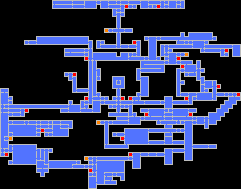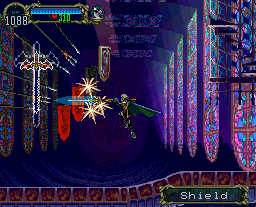Powet Alphabet: I is for Inverted Castle
by Sindra, filed in Articles, Powet Alphabet on Feb.26, 2011
 Since the alphabet is the building block of our language, the Powet Alphabet is the building block of what makes us geeks.
Since the alphabet is the building block of our language, the Powet Alphabet is the building block of what makes us geeks.
You’ve gotten to 99% of the overall castle completed. You’ve gotten this far thinking “Wow, this was a short game, but I guess it was ok”. Then you make it to that last room, only to have a cutscene erupt or being transported to an entirely different room.
But wait! Everything looks different. You haven’t been here before, but you should have 100% of the map done, right? And why is everything upside-down or a new, decayed shade?
Congratulations. You’ve been transported to the Inverted Castle.
 The term “Inverted Castle” can be a blanket definition of a stage or a series of stages in a game that are warped, corrupted or otherwise twisted version of previous stages earlier in the game – usually meant to extend gameplay, but not always. The term is used heavily in the Castlevania series, after half of the game Symphony of the Night took place in an entirely upside-down version of the original castle you’d already played through most of: the 2nd castle being coined “Inverted Castle” or “Reverse Castle”. The concept was later used again in a slightly different way in Castlevania: Harmony of Dissonance by making a second castle that was “out of sync” with the main one, with the layout being similar but certain objects or environments being slightly altered to bypass previous obstacles.
The term “Inverted Castle” can be a blanket definition of a stage or a series of stages in a game that are warped, corrupted or otherwise twisted version of previous stages earlier in the game – usually meant to extend gameplay, but not always. The term is used heavily in the Castlevania series, after half of the game Symphony of the Night took place in an entirely upside-down version of the original castle you’d already played through most of: the 2nd castle being coined “Inverted Castle” or “Reverse Castle”. The concept was later used again in a slightly different way in Castlevania: Harmony of Dissonance by making a second castle that was “out of sync” with the main one, with the layout being similar but certain objects or environments being slightly altered to bypass previous obstacles.
 Other video games have used the concept of a Inverted World, most notably Silent Hill with it’s “Fog World” and the dreaded “Otherworld”. Rather than extend gameplay, however, these different phases of the same area were meant to represent layers of both reality and of the subconscious and used in tandem with each other. Though the “Fog World” was not used in every Silent Hill game, nearly all of them have an “Otherworld” – a twisted, bloody and decayed version of the regular world used to incite fear and thrill the player.
Other video games have used the concept of a Inverted World, most notably Silent Hill with it’s “Fog World” and the dreaded “Otherworld”. Rather than extend gameplay, however, these different phases of the same area were meant to represent layers of both reality and of the subconscious and used in tandem with each other. Though the “Fog World” was not used in every Silent Hill game, nearly all of them have an “Otherworld” – a twisted, bloody and decayed version of the regular world used to incite fear and thrill the player.


 PS3
PS3
 Famicom Dojo
Famicom Dojo KEEP PLAYING
KEEP PLAYING KEEP PLAYING: Rewind
KEEP PLAYING: Rewind Powet Toys
Powet Toys Powetcast
Powetcast Hitchhiker's Guide POWETcast
Hitchhiker's Guide POWETcast














